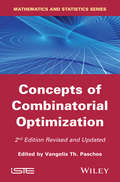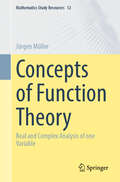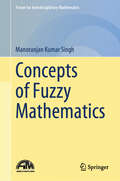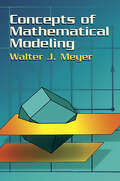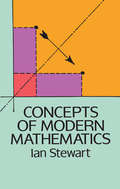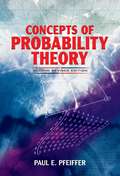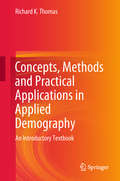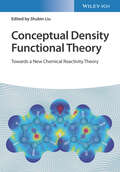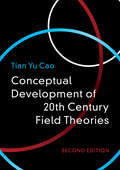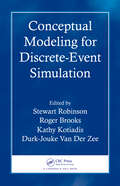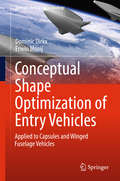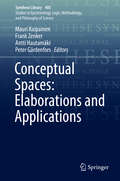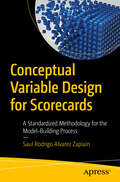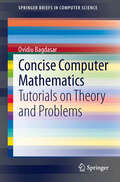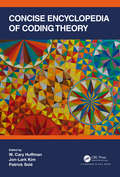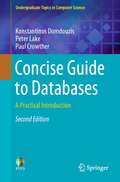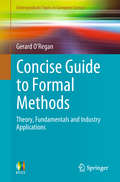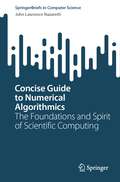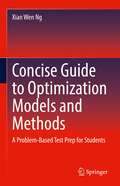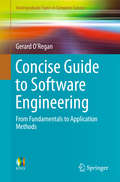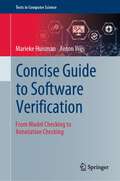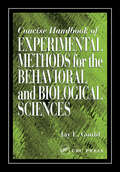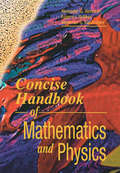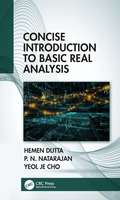- Table View
- List View
Concepts of Combinatorial Optimization (Wiley-iste Ser.)
by Vangelis Th. PaschosCombinatorial optimization is a multidisciplinary scientific area, lying in the interface of three major scientific domains: mathematics, theoretical computer science and management. The three volumes of the Combinatorial Optimization series aim to cover a wide range of topics in this area. These topics also deal with fundamental notions and approaches as with several classical applications of combinatorial optimization. Concepts of Combinatorial Optimization, is divided into three parts: - On the complexity of combinatorial optimization problems, presenting basics about worst-case and randomized complexity; - Classical solution methods, presenting the two most-known methods for solving hard combinatorial optimization problems, that are Branch-and-Bound and Dynamic Programming; - Elements from mathematical programming, presenting fundamentals from mathematical programming based methods that are in the heart of Operations Research since the origins of this field.
Concepts of Function Theory: Real and Complex Analysis of one Variable (Mathematics Study Resources #12)
by Jürgen MüllerThis textbook presents a direct path from real analysis of one variable to function theory. Classical topics of one-dimensional real analysis, such as differential and integral calculus, are largely presented from a complex perspective. The goal is a self-contained exposition extending to the Runge theorems and the dynamics of entire functions. Short sections appended to each chapter on concepts of function theory provide glimpses into higher-dimensional analysis and an impression of its universal significance for mathematics. The book is structured so that parts can also serve as a basis for a seminar. Thus, this fascinating area of mathematics becomes accessible to students whose programs do not focus on mathematics and for whom a classical introduction to function theory would be too time-consuming. This book enables them to take a step into complex analysis, through which they can recognize a multitude of connections that remain hidden in real analysis. The translation was done with the help of artificial intelligence. A subsequent human revision was done primarily in terms of content.
Concepts of Fuzzy Mathematics (Forum for Interdisciplinary Mathematics)
by Manoranjan Kumar SinghThis comprehensive introductory textbook is designed for undergraduate mathematics students seeking to gain a strong understanding of fuzzy sets and relations. Covering all major topics in the field, this course provides a solid foundation in fuzzy mathematics, similar to a pre-calculus course covering algebra, functions and trigonometry. The book is enriched with more than 225 solved examples, 194 challenging problems, 276 multiple-choice questions and 240 true/false statements, making it an ideal companion for students looking to master the basics of fuzzy mathematics. Whether readers are studying on their own or as part of a classroom setting, this book provides a unified and comprehensive treatment of the subject, ensuring that readers have the knowledge and skills they need to succeed.
Concepts of Mathematical Modeling (Dover Books on Mathematics)
by Walter J. MeyerAppropriate for undergraduate and graduate students, this text features independent sections that illustrate the most important principles of mathematical modeling, a variety of applications, and classic models. Students with a solid background in calculus and some knowledge of probability and matrix theory will find the material entirely accessible. The range of subjects includes topics from the physical, biological, and social sciences, as well as those of operations research. Discussions cover related mathematical tools and the historical eras from which the applications are drawn. Each section is preceded by an abstract and statement of prerequisites, and answers or hints are provided for selected exercises. 1984 edition.
Concepts of Modern Mathematics
by Ian StewartSome years ago, "new math" took the country's classrooms by storm. Based on the abstract, general style of mathematical exposition favored by research mathematicians, its goal was to teach students not just to manipulate numbers and formulas, but to grasp the underlying mathematical concepts. The result, at least at first, was a great deal of confusion among teachers, students, and parents. Since then, the negative aspects of "new math" have been eliminated and its positive elements assimilated into classroom instruction.In this charming volume, a noted English mathematician uses humor and anecdote to illuminate the concepts underlying "new math": groups, sets, subsets, topology, Boolean algebra, and more. According to Professor Stewart, an understanding of these concepts offers the best route to grasping the true nature of mathematics, in particular the power, beauty, and utility of pure mathematics. No advanced mathematical background is needed (a smattering of algebra, geometry, and trigonometry is helpful) to follow the author's lucid and thought-provoking discussions of such topics as functions, symmetry, axiomatics, counting, topology, hyperspace, linear algebra, real analysis, probability, computers, applications of modern mathematics, and much more.By the time readers have finished this book, they'll have a much clearer grasp of how modern mathematicians look at figures, functions, and formulas and how a firm grasp of the ideas underlying "new math" leads toward a genuine comprehension of the nature of mathematics itself.
Concepts of Probability Theory: Second Revised Edition
by Paul E. PfeifferThis approach to the basics of probability theory employs the simple conceptual framework of the Kolmogorov model, a method that comprises both the literature of applications and the literature on pure mathematics. The author also presents a substantial introduction to the idea of a random process. Intended for college juniors and seniors majoring in science, engineering, or mathematics, the book assumes a familiarity with basic calculus.After a brief historical introduction, the text examines a mathematical model for probability, random variables and probability distributions, sums and integrals, mathematical expectation, sequence and sums of random variables, and random processes. Problems with answers conclude each chapter, and six appendixes offer supplementary material. This text provides an excellent background for further study of statistical decision theory, reliability theory, dynamic programming, statistical game theory, coding and information theory, and classical sampling statistics.
Concepts, Methods and Practical Applications in Applied Demography: An Introductory Textbook
by Richard K. ThomasThis textbook offers a comprehensive overview of applied demography by presenting both basic concepts and methodological techniques. It allows students from the social and human sciences, demographers, consultants and anyone interested in applied demography to gain an understanding of a wide range of practical applications of demographic concepts, methods and techniques to real- world problems. Featured sidebars highlight relevant terms and concepts and case studies and exercises throughout the book offer first-hand exposure to demographic applications. Charts and graphs supplement the presentation of demographic concepts and a glossary provides an inventory of relevant terms. The first section reviews basic components of applied demography as a context for understanding and addressing societal issues. It details the methods, techniques and data sources applied by demographers in a variety of areas. Coverage includes cohort analysis, data standardization, population estimation, and the use of geographic in- formation systems (GIS). The second section focuses on the substantive areas in which demography is currently applied. The topics covered include business demography, health demography, political demography, educational demography, and applications to urban and regional planning. The book illustrates the many ways in which demographers contribute to the formulation of public policy and the resolution of societal issues.
Conceptual Density Functional Theory: Towards a New Chemical Reactivity Theory
by Shubin LiuConceptual Density Functional Theory A unique resource that combines experimental and theoretical qualitative computing methods for a new foundation of chemical reactivity This two-volume reference book shows how conceptual density functional theory can reconcile empirical observations within silico calculations using density functional theory, molecular orbital theory, and valence bond theory. The ability to predict properties like electronegativity, acidity/basicity, strong covalent and weak intermolecular interactions as well as chemical reactivity makes DFT directly applicable to almost all problems in applied chemistry, from synthetic chemistry to catalyst design and materials characterization. Edited by one of the most recognized experts in the field and contributed to by a panel of international experts, the work addresses topics such as: Qualitative methods that are capable of rationalizing chemical concepts derived from theory and computation Fundamental concepts like the computation of chemical bonding, weak interactions, and reactivity Computational approaches for chemical concepts in excited states, extended systems, and time-dependent processes Theoretical chemists and physicists, as well as those applying theoretical calculations to empirical problems, will be able to use this book to gain unique insight into how theory intersects with experimental data in the field of qualitative computation.
Conceptual Developments of 20th Century Field Theories
by Tian Yu CaoThis new edition of Conceptual Developments of 20th Century Field Theories explores the conceptual foundations and historical roots of fundamental field theories. It also uncovers the underlying issues, logic and dynamics in fundamental physics. In response to new advances in the field over the past twenty years, the sections on gauge theory and quantum field theory have been thoroughly revised and elaborated. The chapter on ontological synthesis and scientific realism has also been reconsidered, now suggesting a new approach that goes beyond structuralism and historicism. Providing an integrated picture of the physical world, it is a valuable resource for theoretical physicists and philosophers of science with an interest in the development of twentieth century mathematical physics. It also provides professional historians and sociologists of science with a basis for further historical, cultural and sociological analysis of the theories discussed.
Conceptual Mathematics
by F. William Lawvere Stephen H. SchanuelIn the last 60 years, the use of the notion of category has led to a remarkable unification and simplification of mathematics. Conceptual Mathematics introduces this tool for the learning, development, and use of mathematics, to beginning students and also to practising mathematical scientists. This book provides a skeleton key that makes explicit some concepts and procedures that are common to all branches of pure and applied mathematics. The treatment does not presuppose knowledge of specific fields, but rather develops, from basic definitions, such elementary categories as discrete dynamical systems and directed graphs; the fundamental ideas are then illuminated by examples in these categories. This second edition provides links with more advanced topics of possible study. In the new appendices and annotated bibliography the reader will find concise introductions to adjoint functors and geometrical structures, as well as sketches of relevant historical developments.
Conceptual Modeling for Discrete-Event Simulation
by Roger Brooks Stewart Robinson Kathy Kotiadis Durk-Jouke van der ZeeBringing together an international group of researchers involved in military, business, and health modeling and simulation, Conceptual Modeling for Discrete-Event Simulation presents a comprehensive view of the current state of the art in the field. The book addresses a host of issues, including: What is a conceptual model?How is conceptual modelin
Conceptual Shape Optimization of Entry Vehicles: Applied to Capsules and Winged Fuselage Vehicles (Springer Aerospace Technology)
by Dominic Dirkx Erwin MooijThis book covers the parameterization of entry capsules, including Apollo capsules and planetary probes, and winged entry vehicles such as the Space Shuttle and lifting bodies. The aerodynamic modelling is based on a variety of panel methods that take shadowing into account, and it has been validated with flight and wind tunnel data of Apollo and the Space Shuttle. The shape optimization is combined with constrained trajectory analysis, and the multi-objective approach provides the engineer with a Pareto front of optimal shapes. The method detailed in Conceptual Shape Optimization of Entry Vehicles is straightforward, and the output gives the engineer insight in the effect of shape variations on trajectory performance. All applied models and algorithms used are explained in detail, allowing for reconstructing the design tool to the researcher's requirements. Conceptual Shape Optimization of Entry Vehicles will be of interest to both researchers and graduate students in the field of aerospace engineering, and to practitioners within the aerospace industry.
Conceptual Spaces: Elaborations and Applications (Synthese Library #405)
by Peter Gärdenfors Frank Zenker Mauri Kaipainen Antti HautamäkiThis edited book focuses on concepts and their applications using the theory of conceptual spaces, one of today’s most central tracks of cognitive science discourse. It features 15 papers based on topics presented at the Conceptual Spaces @ Work 2016 conference. The contributors interweave both theory and applications in their papers. Among the first mentioned are studies on metatheories, logical and systemic implications of the theory, as well as relations between concepts and language. Examples of the latter include explanatory models of paradigm shifts and evolution in science as well as dilemmas and issues of health, ethics, and education. The theory of conceptual spaces overcomes many translational issues between academic theoretization and practical applications. The paradigm is mainly associated with structural explanations, such as categorization and meronomy. However, the community has also been relating it to relations, functions, and systems. The book presents work that provides a geometric model for the representation of human conceptual knowledge that bridges the symbolic and the sub-conceptual levels of representation. The model has already proven to have a broad range of applicability beyond cognitive science and even across a number of disciplines related to concepts and representation.
Conceptual Variable Design for Scorecards: A Standardized Methodology for the Model-Building Process
by Saul Rodrigo ZapiainEmbark on a journey through the intricate landscape of predictive modeling, where the fusion of conceptual clarity and robust statistical techniques creates powerful tools for decision-making. This book distills years of experience into a standardized methodology that empowers professionals across industries—from banking to telecommunications—to construct scorecards that predict outcomes with precision and confidence. In a world driven by data, the ability to transform complex information into actionable insights is paramount. This is your essential guide to mastering the art and science of model building. With practical examples, real-world case studies, and step-by-step guidance, this book is not just a resource—it's a roadmap to success in the rapidly evolving field of analytics. By focusing on reducing operational risk, you&’ll be equipped to make informed decisions that safeguard your organization&’s future. Whether you&’re a seasoned data scientist or just starting your journey, Conceptual Variable Design for Scorecards will provide you with the knowledge and skills to thrive in an era where data-driven decisions are the key to competitive advantage. Join the ranks of forward-thinking professionals who are redefining the future of risk management and predictive analytics. Your journey begins here. What You Will Learn Harness the power of conceptualization to create models that solve real-world problems. Design meaningful variables that reflect the behaviors of your target population. Expand variables with temporal patterns to capture trends and dynamic changes. Master data integration to streamline preparation and avoid common pitfalls. Implement a unified workflow to simplify and accelerate the modeling process. Explore a larger number of variables in your multivariable models by harnessing the use of experimental design and hyperoptimization. Who This Book Is For Professionals engaged in the practical construction of models who seek to gain a comprehensive understanding of the model-building process.
Concise Computer Mathematics: Tutorials on Theory and Problems (SpringerBriefs in Computer Science)
by Ovidiu BagdasarAdapted from a modular undergraduate course on computational mathematics, Concise Computer Mathematics delivers an easily accessible, self-contained introduction to the basic notions of mathematics necessary for a computer science degree. The text reflects the need to quickly introduce students from a variety of educational backgrounds to a number of essential mathematical concepts. The material is divided into four units: discrete mathematics (sets, relations, functions), logic (Boolean types, truth tables, proofs), linear algebra (vectors, matrices and graphics), and special topics (graph theory, number theory, basic elements of calculus). The chapters contain a brief theoretical presentation of the topic, followed by a selection of problems (which are direct applications of the theory) and additional supplementary problems (which may require a bit more work). Each chapter ends with answers or worked solutions for all of the problems.
Concise Encyclopedia of Coding Theory
by W. Cary HuffmanMost coding theory experts date the origin of the subject with the 1948 publication of A Mathematical Theory of Communication by Claude Shannon. Since then, coding theory has grown into a discipline with many practical applications (antennas, networks, memories), requiring various mathematical techniques, from commutative algebra, to semi-definite programming, to algebraic geometry. Most topics covered in the Concise Encyclopedia of Coding Theory are presented in short sections at an introductory level and progress from basic to advanced level, with definitions, examples, and many references. The book is divided into three parts: Part I fundamentals: cyclic codes, skew cyclic codes, quasi-cyclic codes, self-dual codes, codes and designs, codes over rings, convolutional codes, performance bounds Part II families: AG codes, group algebra codes, few-weight codes, Boolean function codes, codes over graphs Part III applications: alternative metrics, algorithmic techniques, interpolation decoding, pseudo-random sequences, lattices, quantum coding, space-time codes, network coding, distributed storage, secret-sharing, and code-based-cryptography. Features Suitable for students and researchers in a wide range of mathematical disciplines Contains many examples and references Most topics take the reader to the frontiers of research
Concise Guide to Databases: A Practical Introduction (Undergraduate Topics In Computer Science Ser.)
by Paul Crowther Peter Lake Konstantinos DomdouzisModern businesses depend on data for their very survival, creating a need for sophisticated databases and database technologies to help store, organise and transport their valuable data. <P><P> This updated and expanded, easy-to-read textbook/reference presents a comprehensive introduction to databases, opening with a concise history of databases and of data as an organisational asset. As relational database management systems are no longer the only database solution, the book takes a wider view of database technology, encompassing big data, NoSQL, object and object-relational, and in-memory databases. Presenting both theoretical and practical elements, the new edition also examines the issues of scalability, availability, performance and security encountered when building and running a database in the real world. <P><P> Topics and features: Presents review and discussion questions at the end of each chapter, in addition to skill-building, hands-on exercisesProvides new material on database adaptiveness, integration, and efficiency in relation to data growthIntroduces a range of commercial databases and encourages the reader to experiment with these in an associated learning environmentReviews use of a variety of databases in business environments, including numerous examplesDiscusses areas for further research within this fast-moving domain With its learning-by-doing approach, supported by both theoretical and practical examples, this clearly-structured textbook will be of great value to advanced undergraduate and postgraduate students of computer science, software engineering, and information technology. Practising database professionals and application developers will also find the book an ideal reference that addresses today's business needs.
Concise Guide to Formal Methods
by Gerard O'ReganThis invaluable textbook/reference provides an easy-to-read guide to the fundamentals of formal methods, highlighting the rich applications of formal methods across a diverse range of areas of computing.Topics and features: introduces the key concepts in software engineering, software reliability and dependability, formal methods, and discrete mathematics; presents a short history of logic, from Aristotle’s syllogistic logic and the logic of the Stoics, through Boole’s symbolic logic, to Frege’s work on predicate logic; covers propositional and predicate logic, as well as more advanced topics such as fuzzy logic, temporal logic, intuitionistic logic, undefined values, and the applications of logic to AI; examines the Z specification language, the Vienna Development Method (VDM) and Irish School of VDM, and the unified modelling language (UML); discusses Dijkstra’s calculus of weakest preconditions, Hoare’s axiomatic semantics of programming languages, and the classical approach of Parnas and his tabular expressions; provides coverage of automata theory, probability and statistics, model checking, and the nature of proof and theorem proving; reviews a selection of tools available to support the formal methodist, and considers the transfer of formal methods to industry; includes review questions and highlights key topics in every chapter, and supplies a helpful glossary at the end of the book.This stimulating guide provides a broad and accessible overview of formal methods for students of computer science and mathematics curious as to how formal methods are applied to the field of computing.
Concise Guide to Numerical Algorithmics: The Foundations and Spirit of Scientific Computing (SpringerBriefs in Computer Science)
by John Lawrence NazarethNumerical Algorithmic Science and Engineering (NAS&E), or more compactly, Numerical Algorithmics, is the theoretical and empirical study and the practical implementation and application of algorithms for solving finite-dimensional problems of a numeric nature. The variables of such problems are either discrete-valued, or continuous over the reals, or, and as is often the case, a combination of the two, and they may or may not have an underlying network/graph structure. This re-emerging discipline of numerical algorithmics within computer science is the counterpart of the now well-established discipline of numerical analysis within mathematics, where the latter’s emphasis is on infinite-dimensional, continuous numerical problems and their finite-dimensional, continuous approximates. A discussion of the underlying rationale for numerical algorithmics, its foundational models of computation, its organizational details, and its role, in conjunction with numerical analysis, in support of the modern modus operandi of scientific computing, or computational science & engineering, is the primary focus of this short monograph. It comprises six chapters, each with its own bibliography. Chapters 2, 3 and 6 present the book’s primary content. Chapters 1, 4, and 5 are briefer, and they provide contextual material for the three primary chapters and smooth the transition between them. Mathematical formalism has been kept to a minimum, and, whenever possible, visual and verbal forms of presentation are employed and the discussion enlivened through the use of motivating quotations and illustrative examples. The reader is expected to have a working knowledge of the basics of computer science, an exposure to basic linear algebra and calculus (and perhaps some real analysis), and an understanding of elementary mathematical concepts such as convexity of sets and functions, networks and graphs, and so on. Although this book is not suitable for use as the principal textbook for a course on numerical algorithmics (NAS&E), it will be of value as a supplementary reference for a variety of courses. It can also serve as the primary text for a research seminar. And it can be recommended for self-study of the foundations and organization of NAS&E to graduate and advanced undergraduate students with sufficient mathematical maturity and a background in computing. When departments of computer science were first created within universities worldwide during the middle of the twentieth century, numerical analysis was an important part of the curriculum. Its role within the discipline of computer science has greatly diminished over time, if not vanished altogether, and specialists in that area are now to be found mainly within other fields, in particular, mathematics and the physical sciences. A central concern of this monograph is the regrettable, downward trajectory of numerical analysis within computer science and how it can be arrested and suitably reconstituted. Resorting to a biblical metaphor, numerical algorithmics (NAS&E) as envisioned herein is neither old wine in new bottles, nor new wine in old bottles, but rather this re-emerging discipline is a decantation of an age-old vintage that can hopefully find its proper place within the larger arena of computer science, and at what appears now to be an opportune time.
Concise Guide to Optimization Models and Methods: A Problem-Based Test Prep for Students
by Xian Wen NgThis concise text contains the most commonly-encountered examination problems in the topic of Optimization Models and Methods, an important module in engineering and other disciplines where there exists an increasing need to operate optimally and sustainably under constraints, such as tighter resource availability, environmental consideration, and cost pressures. This book is comprehensive in coverage as it includes a diverse spectrum of problems from numerical open-ended questions that probe creative thinking to the relation of concepts to realistic settings. The book adopts many examples of design scenarios as context for curating sample problems. This will help students relate desktop problem-solving to tackling real-world problems. Succinct yet rigorous, with over a 100 pages of problems and corresponding worked solutions presented in detail, the book is ideal for students of engineering, applied science, and market analysis.
Concise Guide to Software Engineering
by Gerard O'ReganThis essential textbook presents a concise introduction to the fundamental principles of software engineering, together with practical guidance on how to apply the theory in a real-world, industrial environment. The wide-ranging coverage encompasses all areas of software design, management, and quality.Topics and features: presents a broad overview of software engineering, including software lifecycles and phases in software development, and project management for software engineering; examines the areas of requirements engineering, software configuration management, software inspections, software testing, software quality assurance, and process quality; covers topics on software metrics and problem solving, software reliability and dependability, and software design and development, including Agile approaches; explains formal methods, a set of mathematical techniques to specify and derive a program from its specification, introducing the Z specification language; discusses software process improvement, describing the CMMI model, and introduces UML, a visual modelling language for software systems; reviews a range of tools to support various activities in software engineering, and offers advice on the selection and management of a software supplier; describes such innovations in the field of software as distributed systems, service-oriented architecture, software as a service, cloud computing, and embedded systems; includes key learning topics, summaries and review questions in each chapter, together with a useful glossary.This practical and easy-to-follow textbook/reference is ideal for computer science students seeking to learn how to build high quality and reliable software on time and on budget. The text also serves as a self-study primer for software engineers, quality professionals, and software managers.
Concise Guide to Software Verification: From Model Checking to Annotation Checking (Texts in Computer Science)
by Anton Wijs Marieke HuismanThis textbook overviews the whole spectrum of formal methods and techniques that are aimed at verifying correctness of software, and how they can be used in practice. It focuses on techniques whereby the user has some control over the properties that are being checked. More specifically, it shows a wide range of techniques covering the whole spectrum: from abstract system design to implementation, from bug finding to full proofs, and from techniques that are push-button by design and give a yes/no answer to techniques that require the user to provide explicit guidance to steer the analysis process.Topics and features:Covers a broad spectrum of software verification techniques, from model checking to annotation checkingProvides numerous examples to demonstrate the techniquesFocuses on how techniques can be used (and the main ideas behind how they work), as opposed to how they are implementedExplains strengths and weaknesses of the techniques, providing insight into when to use which technique in practiceThis unique textbook has been written primarily for master’s level students in computer science studying embedded systems and specializing in software technology. The book will also be of interest for students studying cyber security and data science technology, as well as for system or software developers interested in techniques that offer formal guarantees about software.
Concise Handbook of Experimental Methods for the Behavioral and Biological Sciences
by Jay E. GouldAlthough there are many books written on the principles and methods of experimentation, few are written in a succinct, comprehensive outline format. The Concise Handbook of Experimental Methods for the Behavioral and Biological Sciences is based on a popular course taught by the author for more than two decades to assist advanced undergraduate and
Concise Handbook of Mathematics and Physics
by Eugene I. Butikov Alexander S. Kondratyev Alexander G. AlenitsynConcise Handbook of Mathematics and Physics presents a unified and coherent treatment of all the major aspects of modern elementary physics and mathematics. This complete text/reference includes definitions of fundamental notations and physical and mathematical quantities, formulas that express the laws of physics, axioms and theorems of mathematics, and more. The information is organized logically (instead of alphabetically) for better comprehension and quick, convenient access.The book contains extensive cross-referencing between the mathematical and physical sections. reflecting the considerable overlap between these two areas of study and increasing the usefulness of this handbook. Fundamental concepts, theorems, and laws are demonstrated through numerous practical examples and tasks to help build problem-solving skills.
Concise Introduction to Basic Real Analysis
by Yeol Je Cho Hemen Dutta P. N. NatarajanThis book provides an introduction to basic topics in Real Analysis and makes the subject easily understandable to all learners. The book is useful for those that are involved with Real Analysis in disciplines such as mathematics, engineering, technology, and other physical sciences. It provides a good balance while dealing with the basic and essential topics that enable the reader to learn the more advanced topics easily. It includes many examples and end of chapter exercises including hints for solutions in several critical cases. The book is ideal for students, instructors, as well as those doing research in areas requiring a basic knowledge of Real Analysis. Those more advanced in the field will also find the book useful to refresh their knowledge of the topic. Features Includes basic and essential topics of real analysis Adopts a reasonable approach to make the subject easier to learn Contains many solved examples and exercise at the end of each chapter Presents a quick review of the fundamentals of set theory Covers the real number system Discusses the basic concepts of metric spaces and complete metric spaces
